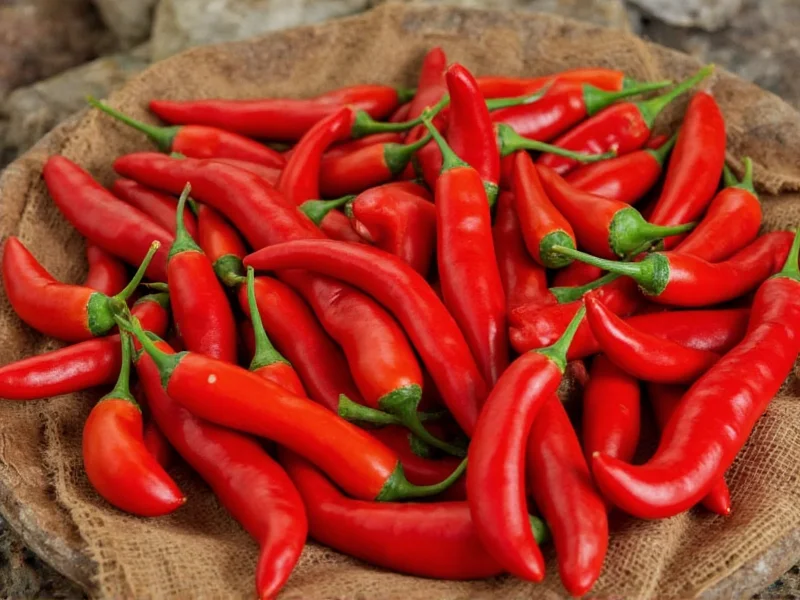Origin and History of Serrano Peppers
The serrano chili (Capsicum annuum) takes its name from the Spanish word "sierra," meaning mountain range, reflecting its native habitat in Mexico's high-altitude regions. Historically cultivated in states like Puebla, Veracruz, and Tamaulipas, serranos have been part of Mesoamerican agriculture for over 500 years. Unlike jalapeños that grow downward, serranos develop pointing skyward on compact plants—a distinctive trait that helps identify them in gardens. Spanish colonizers documented serranos in the 16th century, but indigenous communities had already integrated them into culinary and medicinal practices long before European contact.
Physical Characteristics and Varieties
Serrano peppers typically measure 1–4 inches long with a diameter of about ¼ inch. Their smooth, glossy skin ranges from bright green (immature) to fiery red, orange, or yellow when fully ripe. Unlike thicker-walled jalapeños, serranos have thin flesh that cooks quickly, making them ideal for fresh applications. Several varieties exist:
| Variety | Color at Maturity | Heat Level (Scoville) | Distinctive Features |
|---|---|---|---|
| Standard Serrano | Red | 10,000–23,000 | Most common variety, crisp texture |
| Chipotle Serrano | Brown (smoked) | 8,000–15,000 | Smoked version, earthy flavor |
| Yellow Serrano | Golden yellow | 12,000–20,000 | Slightly fruitier taste |
| Black Mexican | Purple-black | 15,000–25,000 | Rare heirloom variety |
Heat Level and Flavor Profile
With a Scoville rating of 10,000–23,000 units, serranos sit firmly in the medium-hot category—about 2–5 times hotter than jalapeños but significantly milder than habaneros (100,000–350,000 SHU). Their heat builds quickly but doesn't linger as long as some hotter varieties. Flavor-wise, serranos offer a bright, grassy taste with subtle citrus undertones and minimal bitterness. The thin walls allow their flavor to integrate rapidly into dishes, making them superior to jalapeños for fresh salsas where immediate flavor impact matters. When roasted, they develop a complex smokiness that enhances sauces and marinades.
Culinary Applications and Substitutions
Serranos shine in fresh preparations where their crisp texture and immediate heat delivery excel. Mexican cuisine features them prominently in:
- Salsas crudas: Finely diced in pico de gallo or blended into green salsa
- Guacamole: Adds heat without overwhelming avocado's richness
- Adobos: Marinated in vinegar and spices for pickled preparations
- Ceviche: Provides clean heat that complements citrus-cured fish
When substituting, consider these alternatives:
- For less heat: Jalapeño (use 1.5–2 peppers per serrano)
- For similar heat: Fresno pepper (similar flavor profile)
- For more heat: Thai bird chili (use sparingly—1:4 ratio)
Always remove seeds and membranes to reduce heat intensity, and wear gloves when handling large quantities to avoid skin irritation.
Growing Serrano Peppers at Home
Gardeners appreciate serranos for their compact size (18–24 inches tall) and high yield. They thrive in warm climates with 60–90 frost-free days. Start seeds indoors 8–10 weeks before last frost, maintaining soil temperature at 70–85°F. Transplant outdoors when night temperatures stay above 55°F, spacing plants 18 inches apart in full sun. Serranos prefer well-draining soil with pH 6.0–7.0 and consistent moisture (1–2 inches weekly). Harvest begins 70–80 days after transplanting, with peppers maturing from green to red over 2–3 weeks. For continuous production, pick peppers regularly before full color development.
Storage and Preparation Tips
To maximize freshness, store unwashed serranos in a paper bag in the refrigerator's crisper drawer for up to 3 weeks. For longer preservation:
- Freezing: Blanch whole peppers for 2 minutes, then freeze in airtight containers (6–8 months)
- Pickling: Preserve in vinegar brine with garlic and spices (1 year refrigerated)
- Drying: Air-dry or use a food dehydrator until brittle, then grind into powder
When preparing, always cut away from your body and wash hands thoroughly afterward. For safety, use a dedicated cutting board for hot peppers and avoid touching your face. If handling causes skin irritation, apply milk or yogurt to neutralize capsaicin oils.











 浙公网安备
33010002000092号
浙公网安备
33010002000092号 浙B2-20120091-4
浙B2-20120091-4